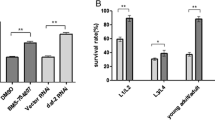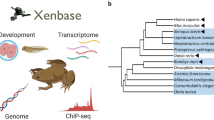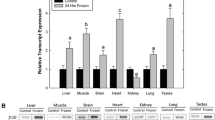Abstract
Various amphibians and reptiles have the extraordinary ability to endure the freezing of body fluids while overwintering. In studies with the wood frog, Rana sylvatica, we continue to explore new facets of vertebrate freeze tolerance. New studies have analyzed modifications of wood frog insulin and the controls on protein kinase A and protein phosphatase1 that regulate glycogen metabolism in order to determine how normal homeostatic control over glucose is overridden to allow glucose to reach the extreme concentrations needed for cryoprotection. The roles of mitogen-activated protein kinases in mediating cell responses to freeze/thaw are also being assessed. Other studies are using cDNA library screening to analyze freeze-induced gene expression. Novel results include the identification of genes, protein products and cell functions that have never before been implicated in natural freezing survival.
Access this chapter
Tax calculation will be finalised at checkout
Purchases are for personal use only
Preview
Unable to display preview. Download preview PDF.
Similar content being viewed by others
References
Alessi DR, Street AJ, Cohen P, Cohen PT (1993) Inhibitor-2 functions like a chaperone to fold three expressed isoforms of mammalian protein phosphatase-1 into a conformation with the specificity and regulatory properties of the native enzyme. Eur J Biochem 213: 1055–1066
Bajaj M, Blundell TL, Horuk R, Pitts JE, Wood SP, Gowan LK, Schwabe C, Wollmer A, Gliemann J, Gammeltoft S (1986) Coypu insulin: primary structure, conformation and biological properties of a hystricomorph rodent insulin. Eur J Biochem 238: 345–351
Cai Q, Greenway SC, Storey KB (1997) Differential regulation of the mitochondrial ADP/ATP translocase gene in wood frogs under freezing stress. Biochim Biophys Acta 1343: 69–78
Cai Q, Storey KB (1996) Anoxia-induced gene expression in turtle heart: up-regulation of mitochondrial genes for NADH-ubiquinone oxidoreductase subunit 5 and cytochrome C subunit 1 Fur J Biochem 241 : 83–92
Cai Q, Storey KB (1997a) Freezing-induced genes in wood frog (Rana sylvatica): fibrinogen upregulation by freezing and dehydration. Am J Physiol 272: R1480-R1492
Cai Q, Storey KB (1997b) Upregulation of a novel gene by freezing exposure in the freezetolerant wood frog (Rana sylvatica). Gene 198: 305–312
Conlon JM, Yano K, Chartrel N, Vaudry H, Storey KB (1998) Freeze tolerance in the wood frog Rana sylvatica is associated with unusual structural features of insulin but not glucagon. J Mol Endocrinol 21: 153–159
Costanzo JP, Lee RE, Wright MR (1992) Cooling rate influences cryoprotectant distribution and organ dehydration in freezing wood frogs. J Exp Zool 261: 373–378
Doherty MJ, Cadefau J, Stalmans W, Bollen M, Cohen PT (1998) Loss of the hepatic glycogenbinding subunit (GL) of protein phosphatase 1 underlies deficient glycogen synthesis in insulin-dependent diabetic rats and in adrenalectomized starved rats. Biochem J 333: 253–257
Greenway SC, Storey KB (1999) Discordant responses of mitogen-activated protein kinases to anoxia and freezing exposures in hatchling turtles. J Comp Physiol 169: 521–527
Greenway SC, Storey KB (2000) Activation of mitogen-activated protein kinases during natural freezing and thawing in the wood frog. Mol Cell Biochem in press
Holden CP, Storey KB (1996) Signal transduction, second messenger and protein kinase responses during freezing exposures in wood frogs. Am J Physiol 271: R1205-R1211
Holden CP, Storey KB (2000) Purification and characterization of protein kinase A catalytic subunit from liver of the freeze tolerant wood frog: role in glycogenolysis during freezing. Cryobiology, in press
Hubbard MJ, Cohen P (1989) The glycogen-binding subunit of protein phosphatase-1G from rabbit skeletal muscle. Further characterization of its structure and glycogen-binding properties. Eur J Biochem 180: 457–465
Huber P, Laurent M, Dalmon J. (1990) Human ß-fibrinogen gene expression: Upstream sequences involved in its tissue specific expression and its dexamethasone and interleukin 6 stimulation. J Biol Chem 265: 5695–5701
Kristensen C Kjeldsen T Wiber FC Schaffer L Hach M Havelund S Bass J Steiner DF Andersen AS (1997) Alanine scanning mutagenesis of insulin. J Biol Chem 272: 12978–12983
Kyriakis JM (1999) Making the connection: coupling of stress-activated ERK/MAPK signalling modules to extracellular stimuli and biological responses. Biochem Soc Symp 64: 29–48
MacDonald JA, Storey KB (1999) Protein phosphatase responses during freezing and thawing in wood frogs: control of liver cryoprotectant metabolism. Cryo-Lett 20: 297–306
Markussen J, Diers I, Hougaard P, Langkjaer L, Norris K, Snel L, Sorensen E, Voigt HO (1988) Soluble, prolonged-acting insulin derivatives. Protein Engineer. 2: 157–166
Rubinsky B, Lee CY, Bastacky J, Onik G (1987) The process of freezing and the mechanism of damage during hepatic cryosurgery. Cryobiology 27: 85–97
Russell EL, Storey KB (1995) Glycogen synthetase and the control of cryoprotectant clearance after thawing in the freeze tolerant wood frog. Cryo-Lett 16: 263–266
Storey KB (1999) Living in the cold: freeze-induced gene responses in freeze-tolerant vertebrates. Clin Exp Pharmacol Physiol 26: 57–63
Storey KB, Storey JM (1988) Freeze tolerance in animals. Physiol Rev 68: 27–84
Storey KB, Storey JM (1996) Natural freezing survival in animals. Ann Rev Ecol Syst 27: 365–386
Storey KB, Storey JM (1997) Adaptations for freezing survival in ectothermic vertebrates. In: (Willis, J.S., ed.) Advances in Molecular and Cell Biology: Thermobiology. JAI Press, London, Vol 19, pp 1–32
Storey KB, Storey JM (1999) Gene expression and cold hardiness in animals. In: Margesin R, Schinner F (eds) Cold-adapted organisms — ecology, physiology, enzymology and molecular biology. Springer, Heidelberg, pp 385–407
Storey KB, Storey JM, Churchill TA (1997) De novo protein biosynthesis responses to water stresses in wood frogs: freeze-thaw and dehydration-rehydration. Cryobiology 34: 200–213
Thomashow MF (1998) Role of cold-responsive genes in plant freezing tolerance. Plant Physiol 118: 1–7
Warren GJ, Thorlby GJ, Knight MR (2000) The molecular biological approach to understanding freezing-tolerance in the model plant, Arabidopsis thaliana. In: Storey KB, Storey JM (eds) Cell and molecular responses to stress, vol l. Elsevier, Amsterdam, in press
White D, Storey KB (1999) Freeze-induced alterations of translatable mRNA populations in wood frog organs. Cryobiology 38: 353–362
Author information
Authors and Affiliations
Editor information
Editors and Affiliations
Rights and permissions
Copyright information
© 2000 Springer-Verlag Berlin Heidelberg
About this paper
Cite this paper
Storey, K.B. (2000). Vertebrate Freeze Tolerance: Molecular Studies of Signal Transduction and Gene Expression. In: Heldmaier, G., Klingenspor, M. (eds) Life in the Cold. Springer, Berlin, Heidelberg. https://doi.org/10.1007/978-3-662-04162-8_55
Download citation
DOI: https://doi.org/10.1007/978-3-662-04162-8_55
Publisher Name: Springer, Berlin, Heidelberg
Print ISBN: 978-3-642-08682-3
Online ISBN: 978-3-662-04162-8
eBook Packages: Springer Book Archive




